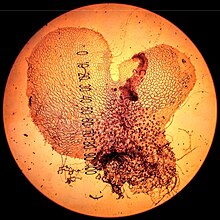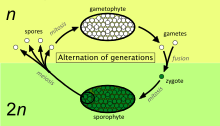21:39
> There is a difference among the flowers of this Valerian, for some are seminiferous, more compactly united, like the heads of Scabiosa.
As opposed to those that are oviparous, which should not be confused with ovoviviparous, which doesn't apply to flora.
I'm not sure oviparous is the normal botanical term here, but I'm spacing on the right one if so.
My gut tells me that oviparous only works with fauna.
> Each carpel in Ranunculus species is an achene that produces one ovule,[4] which when fertilized becomes a seed. If the carpel contains more than one seed, as in Eranthis hyemalis, it is called a follicle. Two or more carpels may be fused together to varying degrees and the entire structure, including the fused styles and stigmas may be called a pistil. The lower part of the pistil, where the ovules are produced, is called the ovary.
The little-froggy flower is a buttercup.
> Gynoecious: having only female flowers (the female of a dioecious population); producing seed but not pollen.
I suppose that will have to do.
> In bryophytes and ferns, the gametophytes are independent, free-living plants, while in seed plants, each female megagametophyte, and the megaspore that gives rise to it, is hidden within the sporophyte and is entirely dependent on it for nutrition.
> As in all vascular plants, the sporophyte is the dominant phase or generation in the life cycle. The gametophytes of ferns, however, are very different from those of seed plants. They are free-living and resemble liverworts, whereas those of seed plants develop within the spore wall and are dependent on the parent sporophyte for their nutrition.
Oh that's right, ferns are bizarre.
It's like there's a mandatory hidden generation nobody sees or thinks about.

A prothallus, or prothallium, (from Latin pro = forwards and Greek θαλλος (thallos) = twig) is usually the gametophyte stage in the life of a fern or other pteridophyte. Occasionally the term is also used to describe the young gametophyte of a liverwort or peat moss as well. In lichens it refers to the region of the thallus that is free of algae.
The prothallus develops from a germinating spore. It is a short-lived and inconspicuous heart-shaped structure typically 2–5 millimeters wide, with a number of rhizoids (root-like hairs) growing underneath, and the sex organs: archegonium (female) and...
> Spore-bearing plants, like all plants, go through a life-cycle of alternation of generations. The fully grown sporophyte, what is commonly referred to as the fern, produces genetically unique spores in the sori by meiosis. The haploid spores fall from the sporophyte and germinate by mitosis, given the right conditions, into the gametophyte stage, the prothallus.
> The prothallus develops independently for several weeks; it grows sex organs that produce ova (archegonia) and flagellated sperm (antheridia). The sperm are able to swim to the ova for fertilization to form a diploid zygote which divides by mitosis to form a multicellular sporophyte.
> In the early stages of growth, the sporophyte grows out of the prothallus, depending on it for water supply and nutrition, but develops into a new independent fern, which will produce new spores that will grow into new prothallia etc., thus completing the life cycle of the organism.
> It has been argued that there is an important evolutionary advantages to the alternation of generations plant life-cycle.[1] By forming a multicellular haploid gametophyte rather than limiting the haploid stage to gametes, there is often only one allele for any genetic trait. Thus, alleles are not masked by a dominant counterpart (there is no counterpart).
One benefit of this is that a mutation that causes a lethal, or harmful, trait expression will cause the gametophyte to die; thus, the trait cannot be passed on to future generations, preserving the strength of the gene pool.[1] Furthe…

Alternation of generations (also known as metagenesis or heterogenesis) is the predominant type of life cycle in plants and algae. In plants both phases are multicellular: the haploid sexual phase – the gametophyte – alternates with a diploid asexual phase – the sporophyte.
A mature sporophyte produces haploid spores by meiosis, a process which reduces the number of chromosomes to half, from two sets to one. The resulting haploid spores germinate and grow into multicellular haploid gametophytes. At maturity, a gametophyte produces gametes by mitosis, the normal process of cell division in eukaryotes...
> Animals develop differently. They directly produce haploid gametes. No haploid spores capable of dividing are produced, so generally there is no multicellular haploid phase. Some insects have a sex-determining system whereby haploid males are produced from unfertilized eggs; however females produced from fertilized eggs are diploid.
> Life cycles of plants and algae with alternating haploid and diploid multicellular stages are referred to as diplohaplontic. The equivalent terms haplodiplontic, diplobiontic and dibiontic are also in use, as is describing such an organism as having a diphasic ontogeny.[5] Life cycles of animals, in which there is only a diploid multicellular stage, are referred to as diplontic. Life cycles in which there is only a haploid multicellular stage are referred to as haplontic.
> Spores are produced by bacteria, fungi, algae, and plants.
I think they left out some of the protists or protozoa.

In biology, a spore is a unit of sexual (in fungi) or asexual reproduction that may be adapted for dispersal and for survival, often for extended periods of time, in unfavourable conditions. Spores form part of the life cycles of many plants, algae, fungi and protozoa.Bacterial spores are not part of a sexual cycle, but are resistant structures used for survival under unfavourable conditions. Myxozoan spores release amoeboid infectious germs ("amoebulae") into their hosts for parasitic infection, but also reproduce within the hosts through the pairing of two nuclei within the plasmodium, which...
> Myxozoan spores release amoeboid infectious germs ("amoebulae") into their hosts for parasitic infection...
> The term spore derives from the ancient Greek word σπορά spora, meaning "seed, sowing", related to σπόρος sporos, "sowing", and σπείρειν speirein, "to sow".
I do so hate Verdana's Greeks.
See how much more pleasing to the eye those Greeks are than these?
That's one of Robert Slimbach's typefaces: Minion-Pro.